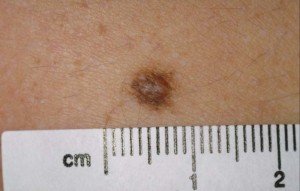
You may have read that moles can be grey in color, but how normal or common is this?
“The most common moles usually have an even pink, tan or brown color,” says Dr. Michael Shapiro, MD, Medical Director and Founder of Vanguard Dermatology in NYC, NY.
“People with darker complexion usually have darker moles than those with fairer skin.
“Grey moles are fairly uncommon and usually seen in discoloration of moles — one of the symptoms of melanoma.

“If the mole changes from its original color to grey, seek out professional medical care.”
A mole that changes colors, regardless of the original color, is suspicious for melanoma skin cancer.
“There’s no specific evidence about patients with grey moles, but I would recommend seeing a doctor if there is any indication of grey or discoloration.”
Data does not exist regarding how common a benign grey mole is. In fact, have you ever seen a grey mole on anyone?
The big question, however, is if a grey mole on your skin used to be the common and normal tan, beige or brown.
A grey mole that was formerly any shade of brown or tan needs to be evaluated by a dermatologist who will likely remove it for a biopsy.
Melanoma often causes a normal pigmented lesion to become altered in color.
Only a biopsy can determine what exactly is going on.
A change in color is a very concerning sign and warrants an immediate evaluation by a dermatologist.
 Dr. Shapiro is a board certified dermatologist and Mohs surgeon and has treated over 12,000 Mohs cases for skin cancer. He is widely published in peer-reviewed academic journals.
Dr. Shapiro is a board certified dermatologist and Mohs surgeon and has treated over 12,000 Mohs cases for skin cancer. He is widely published in peer-reviewed academic journals.
 Lorra Garrick has been covering medical, fitness and cybersecurity topics for many years, having written thousands of articles for print magazines and websites, including as a ghostwriter. She’s also a former ACE-certified personal trainer.
Lorra Garrick has been covering medical, fitness and cybersecurity topics for many years, having written thousands of articles for print magazines and websites, including as a ghostwriter. She’s also a former ACE-certified personal trainer.









































